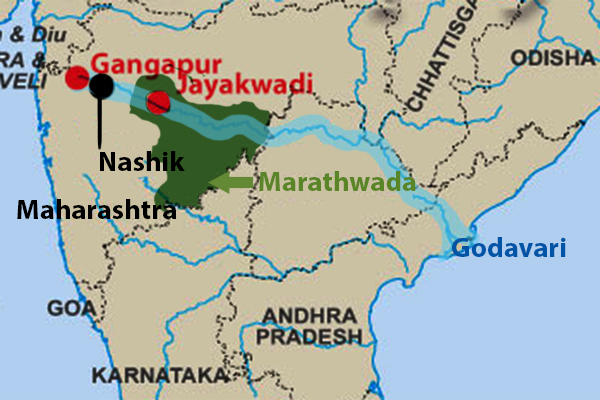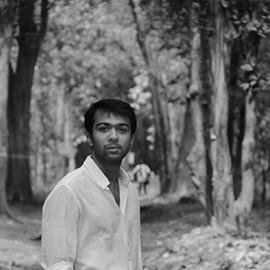Had a dip at the Kumbh? That water could have helped 305 villages

The crisis
- Maharashtra\'s Marathwada region is staring at a drought
- There has been a 51% rainfall deficit this monsoon; 70% Kharif crops have failed
- Riverbeds are parched, tanks dry; 11 reservoirs have 10% water left
The response
- State govt released 3 TMC water for Kumbh dips from Gangapur dam
- Releasing the water from Jayakwadi dam would have helped 305 villages
- The govt budgeted Rs 2,000 crore for the Kumbh, but didn\'t waive off farm loans
There's a city that receives water every 15 days and that may soon become once a month. It has water to sustain itself for a mere month-and-a-half. The two dams on which the district survives have dried up. For the first time, water theft has been reported and it's now common to see padlocked water tankers.
Travel 130 kilometers northwest and you come across parched riverbeds. Miles of cotton and soya bean fields lie desolate with crops barely as high as one's ankle. The administration has had to set up cattle camps as people have little water to drink, let alone look after their livestock.
Drive north a little more than 100 kilometers and you will see people climbing down scorched wells, digging at their base until a muddy puddle forms. They scoop the water for hours, separating the mire and stones, to fill their pots.
But 100 kilometres away from this district, you will find millions getting drenched in massive reservoirs, and river ghats, supposedly washing off their sins.
The unfairness of things
Imagine being a resident of Latur, waiting 15 days to get water, or being a farmer in Beed, who has been forced to renounce his livestock, or that man in Jalna, who is digging the bottom of the well in the hope of espying some drinking water. And then imagine watching sants and sadhus enjoying a dip at the Kumbh Mela in Nashik.
Monsoons usually bring 780 millimetres of rainfall to Maharashtra's Marathwada region. This year that has come down to 259 mm. The met department's figures indicate an ominous 51% deficit and district officials say more than 70% Kharif crops have failed.
The 11 major reservoirs of the region have less than 10% water left and more than 600 farmers here have committed suicide this year. Official records show 80% of the state is staring at a drought.
At a time like this the Maharashtra government released two TMC (thousand million cubic) water from the Gangapur dam for the Kumbh's second Shahi Snan (Royal Dip) on 13 September. One TMC was released on 29 August for the first Snan and one TMC more is expected to be released on 18 September.
What was the government thinking?
At least there is no ambiguity about the priorities of this government.
The Snan is a ritual valued by a large section. The Kumbh takes place once in three years in Haridwar, Allahabad, Nashik and Ujjain, by rotation. Nashik has waited for this occasion for 12 years. The government has budgeted over Rs 2,000 crore for the event.
At the same time, it has not waived off farm loans. Given the intensity of the drought in Marathwada, it was not too much to expect.
The Gangapur dam, from which water was generously bestowed to the Kumbh, is upstream of the Jayakwadi dam, on which most of the irrigation projects and 305 villages in Marathwada depend. Had the water been released through that dam, it would have helped significantly.

The Mumbai High Court, has asked the government to "reconsider" its decision (though it has come after two of the three Snans are over). "The government has a policy, which categorizes its priorities as far as supply of water is concerned. As per the policy, supply of water for drinking purposes comes first and supply of water for such Shahi Snans comes in the last category," the court said.
The judgment comes on the back of a public interest litigation filed by HM Desarda, an economics professor from Pune. The petition said the released water would be a "sheer waste, given the drought situation in the state and the grave danger it posed to human survival."
According to the National Water Policy, preference should be given to drinking needs, followed by agriculture and then commercial purposes. The petitioner argued the government's decision violated the policy.
"The petitioner pointed out to apex court orders, which states that access to drinking water is a fundamental right and it is State's duty to provide drinking water under Article 21 (Right to Life) of the Constitution," the Bench pointed out.
Astonishingly, the government pleader said such a move would lead to a "law-and-order situation" as lakhs of devotees throng Nashik. Irrespective of whether it was just a precautionary warning or a threat, this indicates the sensitivities of the society. Seems we worry more about religious sentiments than farmers' lives.
One million people took the first Royal Dip and four million the second. Did the dire situation in Marathwada not even occur to the sadhus while practicing their religious ritual?
Pradeep Purandare, a former expert member of the Marathwada Statutory Development Board, says even if the water is released, it should not be given away free of cost. "The water is valuable," he says. "When you give it away free of cost, people consuming it do not realize its value."
If Sahi Snan continues, it would do irreparable damage to Godavari - Marathwada's life line
The water audit of 2010 shows that 30% of the total water usage falls under the "other" category. While the remaining 70% is used for drinking, commercial and agricultural purposes, the "other" category is not defined.
Studies show that there is hardly anything royal about the Godavari river, in which millions take the Royal Dip: Industrial discharge and domestic waste has severely polluted the river, making it grossly unfit to bathe in.
Experts believe if the Shahi Snan continues this way, it would irreparably damage the Godavari, also known as the lifeline of Marathwada since it fills up the critical Jayakwadi dam.
Rajesh Pandit and Nishikant Pagare, environmental activists from Nashik, had filed a petition in the Mumbai High Court in 2012 urging the government to clean the river up.
But nobody seems bothered. On the other contrary, it was reported on 13 September that a high-level delegation, including the Chief Minister's wife, would soon fly to China to import 'holy' water from Kailas Manas Sarovar to pour it in the Godavari to appease the Sadhus.
The abuse of Godavari or the endemic suicides of farmers should surmount religious sentiments. But they don't.






![BJP's Kapil Mishra recreates Shankar Mahadevan’s ‘Breathless’ song to highlight Delhi pollution [WATCH] BJP's Kapil Mishra recreates Shankar Mahadevan’s ‘Breathless’ song to highlight Delhi pollution [WATCH]](https://images.catchnews.com/upload/2022/11/03/kapil-mishra_240884_300x172.png)

![Anupam Kher shares pictures of his toned body on 67th birthday [MUST SEE] Anupam Kher shares pictures of his toned body on 67th birthday [MUST SEE]](https://images.catchnews.com/upload/2022/03/07/Anupam_kher_231145_300x172.jpg)






